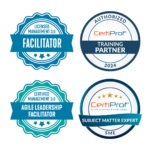Introduction
In this article, I will explain how we organize OKRs in conjunction with Management 3.0 practices
Team Context
This team consisted of 20 people, divided into 3 squads with very specific assignments. They were responsible for a meditation application, where subscribers have access to music and sound to meditate, in addition to guided meditations. While a Squad was responsible for actions aimed at bringing in new customers, the second Squad worked to keep them in the application and the third Squad took care of all the technical aspects of the application itself. There were many challenges related to the integration of these people, as they have very different profiles. In addition, they had a low maturity in Agility. Because it is a very specific market, they still faced difficulties in understanding the customer. On the technical side, they had to redo the application more than once due to switching suppliers – while also having to keep customers satisfied. As responsible for Agility in this team, in addition to training related to Agile Methods and business techniques, I introduced Management 3.0 practices to deal with various issues, such as conflicts, lack of a safe environment, transparency, and trust.
Explanation: OKR?
OKRs (Objectives and Key Results) are a goal-setting framework used to define and track progress toward business objectives. The purpose of OKRs is to align individual, team, and organizational goals to a shared vision and to help teams focus their efforts on achieving measurable results that move the company forward.
Management 3.0 recommends OKR as a practice as it helps us align constraints, one of the pillars of Management 3.0. It also includes 12 metrics rules that help in creating good metrics and avoiding pitfalls.
By setting specific, challenging objectives and defining key results that measure progress towards those objectives, OKRs help organizations stay focused and aligned on what truly matters. They also encourage transparency, accountability, and continuous improvement by providing a framework for ongoing evaluation and feedback. Additionally, OKRs can help foster a culture of collaboration and teamwork by encouraging individuals and teams to work towards common goals that are aligned with the company’s overall strategy.
Why do we decide to use this practice?
There are several reasons why the team developing the ATMA meditation app could benefit from using OKRs (Objectives and Key Results) to organize their goals and track progress. First, OKRs can help the team prioritize their work and focus on the most important objectives that will drive the success of the app. With so many potential features and improvements, it can be easy for the team to lose sight of what matters.
Second, OKRs can provide a framework for measuring progress towards these goals and holding the team accountable for achieving them. By setting specific, measurable key results that are tied to the overall objective of improving user engagement, the team can ensure that they are making meaningful progress toward their goals.
Finally, using OKRs can help keep the team motivated and engaged by providing a clear sense of purpose and direction. When everyone on the team understands what they are working towards and how their work contributes to the overall success of the app, they are more likely to feel fulfilled and satisfied in their roles. Overall, using OKRs can help the ATMA team stay focused, aligned, and motivated, and ultimately lead to a more successful app
How did we use this practice
The team already had a history of lack of prioritization, with many issues coming directly from management in a disorganized way.
I gave training on OKRs, both on creating and writing OKRs and on the 12 rules for metrics. The main objective of the training was, at first, to give this vision that OKRs need to be built by the team itself, but without forgetting the alignment with the business area.
We realized that the business objectives themselves were not so clear to the team, so it was time to also increase this understanding and purpose alignment.
With the help of the 12 rules for metrics and some OKR templates already in the correct format, we used it to create our first cycle, composed of 2 objectives with 3 Krs in each one. We followed up the first 3 months with biweekly meetings in conjunction with team ceremonies – which used Scrum. At the end of the cycle, we collect feedback and adjust our route for the next cycle.
As we had previously introduced Feedback Wrap to the team, it made it much easier to generate these end-of-cycle feedbacks in a constructive way to improve OKRs in the next cycle.
My learnings as a facilitator
Dynamics of creating OKRs is always a challenge and associating this practice with the others for about a week, it was possible not only to better understand the team but to help them think properly about what they wanted to look for in terms of objectives and results in the next quarter. It was essential to clarify what motivated the team so that the OKRs made sense and generated a sense of belonging.
Next Experiments with This Practice
I always try to tell participants the purpose of the practice and how they can use it. It is not easy to implement OKRs throughout the organization, but when a team starts to stand out in the correct use, it is natural to notice problems in the business strategies. With that, a great experiment would be to take the knowledge of OKRs and the 12 rules for metrics to the C-Levels and develop strategic OKRs, not just the tactical, operational, and personal ones. Showing the results of the local team already implemented, would help to take it to the top management because it already has evidence created.
References:
Artigo elaborado como parte do processo para a certificação Management 3.0 Practitioner
Article was written as part of the Management 3.0 Practitioner certification process



